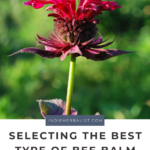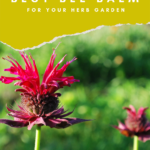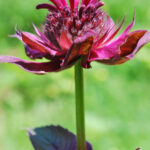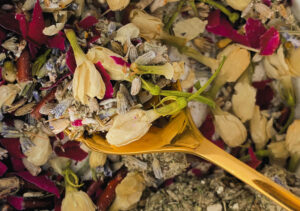Links contained in this post and elsewhere on my website may include affiliate links. When you make a purchase through these links, I earn a commission at no additional cost to you. I only link to products and services that I love - and that I think you will love, too!
Bee balm is one of my favorite plants. In addition to providing nectar for bees and butterflies, these showy native plants have herbal uses, too! There are several types of bee balm, and each has a unique herbal profile. Improved varieties of bee balm may create a stunning display of flowers for pollinators but may not have what it takes to make it into your herbal cupboard. Here’s how to make a selection that will make the cut for your garden and your herbal cupboard.
Types of bee balm by species
There are a few species of bee balm. Monarda fistulosa, sometimes known as wild bergamot, has lavender colored flowers and is widely distributed east of the Rockies. Monarda didyma is known as scarlet bee balm, Oswego tea, and bergamot. However, this species is more localized to the eastern United States.
Both species have similar herbal uses, but there are distinctions between them. Plus, the varieties available in garden centers are usually either named varieties of a single species or hybrids of two different bee balm species, making things even more nuanced for home herbalists.
Important garden characteristics for bee balm
When choosing a bee balm for your garden, personal preference and garden settings play a role. Traditional bee balm usually stays under four feet tall, but hybrids may be much taller. This isn’t necessarily a bad thing. Taller plants make for showier displays and higher harvest yields!
Hybrids can also have a more balanced approach to water needs or have better drought resistance than the original types. M. fistulosa tolerates dry conditions, but M. didyma needs regular water or moist soils.
Scarlet bee balm, M. didyma, is also known for struggling with powdery mildew. Some of this can be corrected by garden conditions (good soil, regular water, sufficient airflow) but mildew-resistant strains have also been developed. That’s another point in favor of hybrids.
Best bee balms for herbalists
Of course, as an herbalist, you are also selecting based on the traditional benefits of bee balm. This is where working with some of the hybrids can be tricky.
Generally, M. didyma has a sweeter, more citrusy fragrance. M. fistulosa smells more like oregano and mint. M. didyma is the variety I prefer for urinary tract infections, sunburns, and supporting the nervous system. It is more cooling and moistening according to traditional classifications. On the other hand, M. fistulosa is fantastic for supporting the digestive tract, immunity, and respiratory system and is more warming and drying.
I encourage herbalists to grow both the original species if they can so that they are familiar with the traditional plant. Seeds are often available from herbal suppliers like Strictly Medicinal Seeds and Richters. After that, you’ll have a good baseline for experimenting with hybrids in your herb garden.
Many hybrids have the same qualities as the traditional strains and it’s fun to explore the differences or find the “perfect” variety for your garden. Right now, ‘Fireball’ (a scarlet flowered bee balm hybrid) is doing extremely well in my garden. It has the sweet, bergamot fragrance and taste that I prefer, plus better mildew resistance. As a bonus, it has the biggest leaves I’ve ever seen on a bee balm, so it is potentially a high-yield variety.
Remember that when working with hybrid types of bee balm, you’ll need to rely on your senses of taste and smell to compare varieties. I had an unnamed variety of lavender flowered bee balm that I bought at a big box garden center. Butterflies and bees loved it, and it formed a truly impressive hedge when I planted it out in a row. However, the fragrance of the leaves was absolutely acrid and rank. Needless to say, it didn’t make the cut for my herbal cupboard!
Learn more about bee balm
I hope you enjoy working with this beautiful herbal ally and learning to select the best type for your garden. The Mt. Cuba Center has done some incredible work in its trial gardens and is a great resource for learning more about different species and hybrids of monarda. If you’d like to learn more about using bee balm like an herbalist, here are some other articles you might enjoy!
Learn more about the wellness benefits of this plant in herbal uses for bee balm and in Using Bee Balm for Emotional Wellness.
Make infused water with watermelon, bee balm and mint to enjoy this summer!






